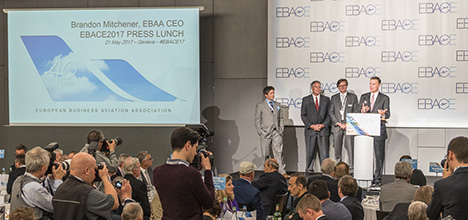Business Aviation Leaders Tout Cross-Atlantic Advocacy to Carry Industry Forward
21 May 2017
At the opening of the 2017 European Business Convention & Exhibition (EBACE2017), the leaders of business aviation groups from Europe and North America underlined the importance of advocacy as the industry returns to growth on both continents.

“This is a fortunate time to have joined the industry, because it’s growing,” said Brandon Mitchener, appointed in April 2017 as the new CEO of the European Business Aviation Association (EBAA). “After years of sluggishness, we’ve had six months of growth in traffic, with the first quarter up 6.7 percent compared to the year before.”
Optimistic that growth would continue, Mitchener cited new business models, including those provided by online booking platforms, and new market opportunities, such as the new European Aviation Safety Agency (EASA) rules permitting commercial IMC operations of single-engine turboprops in Europe.
“These things don’t happen by themselves,” said Mitchener at the EBACE2017 Media Luncheon, “EBAA worked closely with EASA on safety considerations for single-engine turboprops. We’re also advocating to let business aircraft use up to 80 percent of European runways, up from 60 percent.”
The commercial IMC certification for single-engine turboprops is the result of a 20-year effort, added Pete Bunce, president and CEO of the General Aviation Manufacturers Association.
Bunce emphasized how important it was for aviation leaders from both sides of the Atlantic to work together, recalling that when colleagues from the European General Aviation Manufacturers Association (EGAMA) joined him on a recent series of Capitol Hill meetings in Washington, DC, it made U.S. lawmakers more receptive to their combined advocacy message.
Emissions, Innovation and Airport Access
Specifically, Bunce said the entire industry needs to work together on innovation, environmental sustainability and offering input on the risk-based approach EASA is writing into its new basic regulation.
Nicolas Chabbert, chairman of EGAMA, said the commercial IMC certification for single-engine turboprops is significant because, “general aviation is about innovation and making the best use of the available technology to provide a transportation tool with no compromise in terms of safety.”
Asked about the associations’ plans for advocacy given pressure in some European communities to close general aviation airports for residential development, Mitchener said that is public perception problem the industry needs to address together.

The president of the National Business Aviation Association (NBAA) agreed. “Our ability to define ourselves is fundamental to the future of business aviation in Europe, in the United States and the rest of the world,” said NBAA President and CEO Ed Bolen. “We need to be very public and transparent about the exceptional job we do.”

